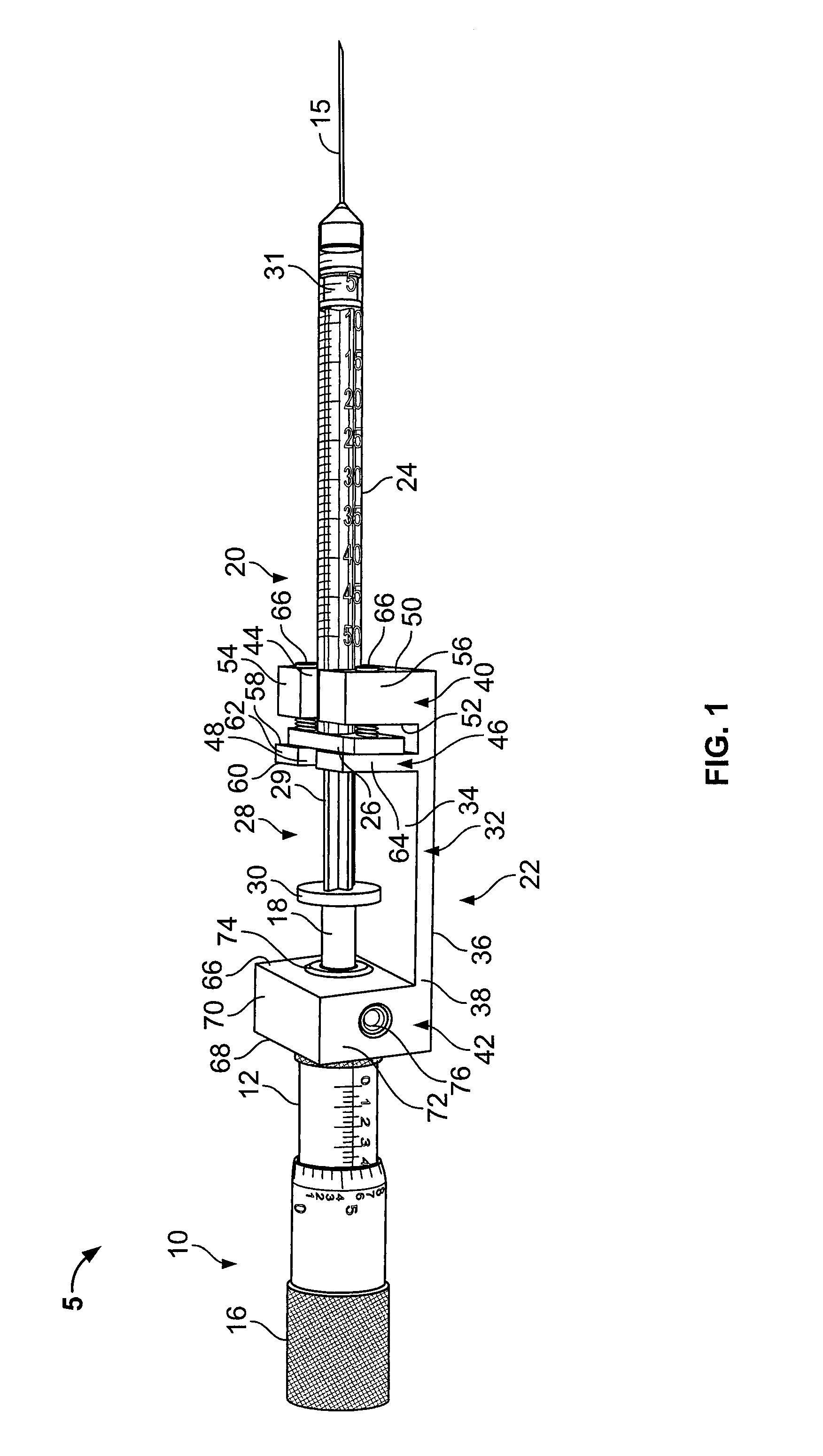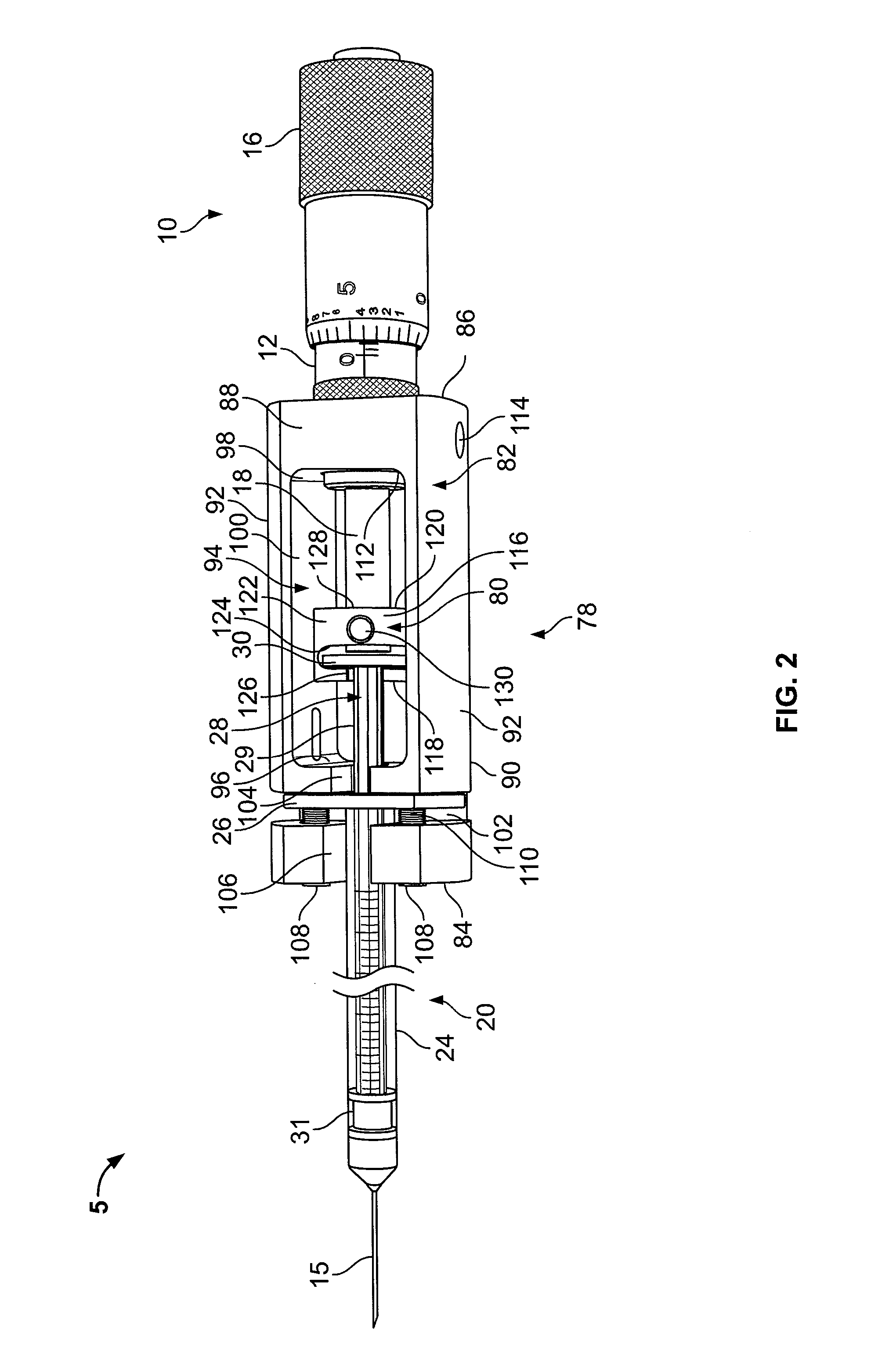Apparatus and methods for delivering fluid and material to a subject
a technology of apparatus and fluid, applied in the direction of infusion needles, other medical devices, infusion syringes, etc., can solve the problems of unfavorable small-volume injection methods, large arrangement that is unwieldy to operate, and lack of mechanisms
- Summary
- Abstract
- Description
- Claims
- Application Information
AI Technical Summary
Benefits of technology
Problems solved by technology
Method used
Image
Examples
example 1
Use of the Micrometer Assisted Delivery Device to Deliver a Hair Follicle Cell Suspension to a Subject
[0080] In this example, the embodiment of the micrometer assisted delivery device used may be any of the embodiments described above or shown in FIGS. 1-8.
[0081] Preparing the Micrometer Assisted Delivery Device
[0082] A ½ inch long 0.5 cc insulin needle is placed in the micrometer assisted delivery device holder and secured. The user should verify that the needle bevel is facing upward between the 10 o'clock to 2 o'clock positions. The user should then aspirate the required amount of solution into the micrometer assisted delivery device by turning the micrometer adjustment thimble clockwise. To push the syringe plunger forward, the user turns the micrometer adjustment thimble counterclockwise. If an air bubble is present, the user should remove by tapping the syringe body and expelling the air bubble out vertically, continue until a small volume of solution appears on the tip of ...
example 2
Use of Fluid Delivery Device to Deliver a Hair Follicle Cell Suspension to a Subject
[0088] In this example, the embodiment of the fluid delivery device used may be any of the embodiments described above or shown in FIGS. 9-15.
[0089] Preparing the Fluid Delivery Device
[0090] The needle of the syringe cartridge is placed within a cell suspension. The plunger of the syringe cartridge is rotated to pull back the syringe head and draw the cell suspension into the syringe cartridge. The syringe cartridge is placed within the housing body of the fluid delivery device. The trigger is depressed down and up until the cell suspension is visible on the needle tip.
[0091] Needle Insertion
[0092] The user should slide the needle superficially into the skin keeping the needle bevel side up and needle parallel to the surface of the skin. Tension in the skin may be increased by pinching the skin, spreading the skin between the user's fingers or pushing forward on the skin surface. The increased s...
example 3
Use of the Cellular Material Delivery Device
[0096] In this example, the embodiment of the cellular material device used may be any of the embodiments described above or shown in FIGS. 16-20.
[0097] Trichogenic epithelial and dermal cells were aggregated and placed in a suspension on the back of a nu / nu mouse. Using the cellular material device, the skin of the mouse was pierced and the device was inserted into the mouse, the annular grooves picking up the suspension from the surface and conveying the material beneath the surface of the skin of the mouse. The injections were repeated by 20× penetrations of the skin through the cell suspension drop. After 10 days of incubation hair follicle formation was seen within the dermis. This experiment was repeated, with the same success, on two further occasions using the same needle configuration.
PUM
 Login to View More
Login to View More Abstract
Description
Claims
Application Information
 Login to View More
Login to View More - R&D
- Intellectual Property
- Life Sciences
- Materials
- Tech Scout
- Unparalleled Data Quality
- Higher Quality Content
- 60% Fewer Hallucinations
Browse by: Latest US Patents, China's latest patents, Technical Efficacy Thesaurus, Application Domain, Technology Topic, Popular Technical Reports.
© 2025 PatSnap. All rights reserved.Legal|Privacy policy|Modern Slavery Act Transparency Statement|Sitemap|About US| Contact US: help@patsnap.com



